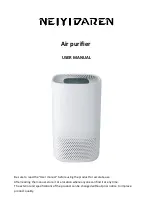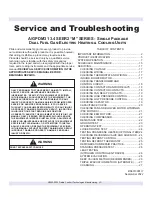
26
EN
Specifications are subject to change without notice.
© 2022 Mitsubishi Electric US, Inc.
Setting addresses
(Be sure to operate with the main power turned OFF.)
<Address board>
PA79D202H01
17
M1 M2
M1 M2 S
M1 M2 S
Controller
ME
Controller
Unit
TB3
TB5
TB5
Unit
Unit
Typical transmission wire connections
when using ME remote controllers
ME
Outdoor
Indoor
Indoor
Note:
Ensure that the wiring is not pinched when fitting the terminal box
cover. Pinching the wiring may cut it.
Caution:
Install wiring so that it is not tight and under tension. Wiring under
tension may break or overheat and burn.
Fix power source wiring to control box by using buffer bushing or
tensile force. (PG connection or the like.) Connect transmission
wiring to transmission terminal block through the knockout hole of
control box using ordinary bushing.
After wiring is complete, make sure again that there is no tension on
the connections, and attach the cover onto the control box in the
reverse order removal. Also, seal any openings created from wiring
into the air handler. This will prevent air leakage.
Caution:
Wire the power supply so that no tension is imparted. Otherwise
disconnection, heating or fire may result.
Important:
Attach shielding ground on the outdoor unit’s ground terminal.
If the remote controller cable exceeds 10 m [32 ft], use a 1.25 mm
2
[AWG16] diameter cable over the exceeded portion, and add that
exceeded position to within 200 m [656 ft].
The BC controller is required only for simultaneous cooling and
heating series R2.
14.B. Connecting Line Voltage
Make sure power supply is off.
Connect the conduit to the air handler cabinet using a 1/2" connector.
Ensure there is no air leak and seal properly if required.
On the line voltage terminal block loosen the screws marked L1, L2
and G on the line voltage terminal strip. Insert line voltage wires and
tighten screws.
Changing the power voltage setting
(Be sure to operate with the main power turned OFF)
Please set the switch SW5 according to the power voltage.
-Set SW5 to 240V side when the power supply is 230 volts
-When the power supply is 208 volts, set SW5 to 220V side.
Model
Indoor Unit
Hz Volts
Voltage
Range
MCA
Output
(kW)
FLA
P12
60
208/230V
188 to
253V
3.00/3.00 0.121
2.4
P18
3.00/3.00 0.121
2.4
P24
3.00/3.00 0.121
2.4
P30
4.13/4.13 0.244
3.0
P36
4.13/4.13 0.244
3.0
P48
5.63/5.63 0.430
4.5
P54
5.63/5.63 0.430
4.5
Setting addresses
(Be sure to operate with the main power turned OFF.)
<Address board>
Lower right corner
of circuit board
SW14
SW12
SW11
There are two types of rotary switch setting available: setting
addresses 1 to 9 and over 10, and setting branch numbers.
How to set addresses:
Example: If Address is “3”, leave SW12 (for over 10) at “0”,
and match SW11 (for 1 to 9) with “3”
How to set branch numbers SW14 (Series R2 only):
Match the indoor unit’s refrigerant pipe with the BC
controller’s end connection number. If there is no BC
controller used leave at “0”.
The rotary switches are all set to “0” when shipped from the factory.
These switches can be used to set unit addresses and branch
numbers at will.
The determination of indoor unit addresses varies with the system
at site. Set them referring to technical data.
_____________________________________
Sensing room temperature with the built-in sensor in
a remote controller
If you need to sense room temperature with the built-in sensor on
a remote controller, set SW1-1 on the control board to “ON”. The
setting of SW1-7 and SW1-8 as necessary also makes it possible
to adjust the air flow at a time when the heating thermometer is off.
There are two types of rotary switch setting available: setting
addresses 1 to 9 and over 10, and setting branch numbers.
How to set addresses:
Example: If Address is “3”, leave SW12 (for over 10) at “0”, and
match SW11 (for 1 to 9) with “3”.
How to set branch numbers SW14 (Series R2 only):
Match the indoor unit’s refrigerant pipe with the BC controller’s
end connection number. If there is no BC controller used leave
at “0”.
The rotary switches are all set to “0” when shipped from the factory.
These switches can be used to set unit addresses and branch
numbers at will.
The determination of indoor unit addresses varies with the system at
site. Set them referring to technical data.
Sensing room temperature with the built-in sensor in
a remote controller
If you need to sense room temperature with the built-in sensor on
a remote controller, set SW1-1 on the control board to “ON”. The
setting of SW1-7 and SW1-8 as necessary also makes it possible to
adjust the air flow at a time when the heating thermometer is off.
When the Heater is used, DIP switch should be set
When the heater is used, set the DIP switch 3-2 on the control board
to “ON”. When DIP switch 3-2 is “ON” and the heater is on, the fan
will operate at high speed regardless of the fan setting in the remote
controller. Refer to service manual for more information on electric
heat operation.
1 2 3 4 5 6 7 8 9 10
ON
OFF
1 2 3 4 5 6 7 8 9 10
ON
OFF
SW3
Factory setting : SW3-2=OFF
Heater not available
Heater available
13.3. Condensate overflow safety switch con
-
nection (CN4F)
The circuit board is equipped with a connection to attach a
condensate safety float switch. The switch should be a normally
closed low voltage rated switch. The switch should be installed in a
location that it can sense a drain blockage causing a rise in water
level. This resulting rise in level will cause it to open. The switch
location is to be determined by the installing contractor. When the
switch opens, it will cause the LEV to close, stopping the cooling
operation. The fan will continue to run and a fault code will be shown
at the controller. Correcting the problem and closing the switch will
be required before normal operation can resume.
See installation below:
Locate the CN4F connector on the
control board. Carefully remove the
connector with the jumper from the
board. Cut the jumper on the CN4F
connector and wire a normally
closed safety float switch across
the wires. Carefully reinstall the
connector back on the board.
When the Normally Closed Float
Switch opens, the Indoor unit will
turn off.
















































